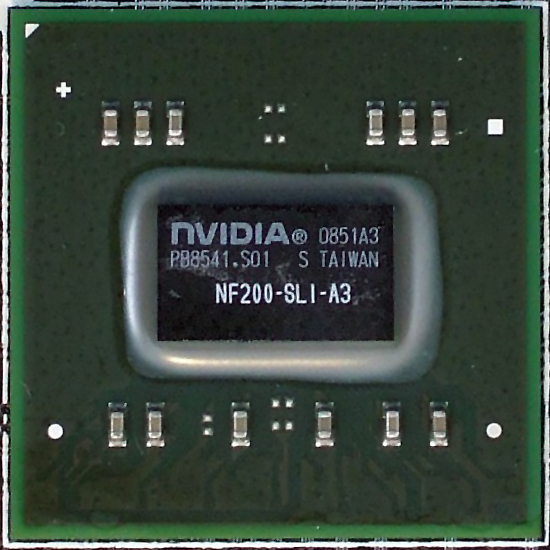PCIe And CrossFire Scaling: Does Nvidia's NF200 Fix P55?
When Does 16/2=32?
Our recent analysis of three-card CrossFireX on P55-based motherboards demonstrated that the bandwidth restrictions of the third slot’s first-gen PCI Express (PCIe) x4 interface was the most likely cause of dramatic performance drops in some games, compared to an otherwise-identical dual-GPU configuration. The LGA 1156 interface’s native support for 16 PCIe 2.0 lanes (running at 5 Gb/s) across a maximum of two devices leaves the P55 chipset’s slow 2.5Gb pathways as the only means for hosting additional devices. Many of our forum members would label the attempts made by several manufacturers to add a third x16-length slot to LGA 1156 platforms as failures of epic proportions.
But what if the third slot didn’t have to rely on the platform controller hub to facilitate lackluster throughput? Certainly some other type of data hub could be devised to allow the processor’s 16 lanes to be divided three ways, with the equivalent bandwidth of five 5.0Gb lanes feeding each card, right? Alright, so the cards can't really operate in x5 mode. But surely an add-in device, if smart enough, could spread that bandwidth across eight lanes. Because the Lynnfield-based Core i7/i5's PCIe controller is only able to host two devices, the add-in part would have to present itself to the CPU as a single component, negotiating data traffic to any connected graphics cards using its own logic.
Fortunately these types of devices, called PCIe bridges, already exist. Nvidia has long used its nForce 200 bridge to “transform” the PCIe 1.1-equipped 680i SLI chipset into the PCIe 2.0-equipped 780i. While many of the 780i’s critics pointed to the northbridge as a bottleneck, the NF200 proved itself extremely capable of managing the bandwidth disparity.
And yet our previous CrossFire examination began with a PCIe performance analysis that showed a 4% slow-down between x16 and x8 PCIe 2.0 slots. Wouldn’t dropping to the equivalent of five lanes of bandwidth per card result in an even more dramatic performance decrease? Two motherboards that arrived for our recent Extreme Motherboard Shootout gave us the opportunity to find out.
Get Tom's Hardware's best news and in-depth reviews, straight to your inbox.
-
liquidsnake718 Score One for the X58. The NF200 should help the P55 however but at an added cost. ALl in all interesting to see that Nvidia has been busy making this for the onboard and motherboard vendors instead of focusing on the GF100. I am sure they are really strategizing and letting AMD/ATi get the upper hand for a short time as their target market for business is also reaching a wider market in motherboard vendors. Then when GF100 comes out, ppl will see the type of quality GPUs that are meant to please the eye and take on the best and most demanding apps/games/HD content.Reply -
outlw6669 With dual CrossFire/SLI (where it really matters most) it is kinda hard to fix something that ain't broken.Reply
Nice gains with three way though.
Pretty sure if you have $1200 to dump on GPU's you would have gotten the proper platform in the first place... -
apache_lives well there you go, high end x58/1366 systems with a high end price offer the higher performance, and pushing a mid-range 1156 platform to high end performance requires extra exotic equipement/chips to do it - no new news hereReply -
apache_lives outlw6669With dual CrossFire/SLI (where it really matters most) it is kinda hard to fix something that ain't broken.Nice gains with three way though.Pretty sure if you have $1200 to dump on GPU's you would have gotten the proper platform in the first place...Reply
Exactly my point +1000 -
2shea It proves again that the x58 is stock the best performer albeit not very much in comparison with the buffed up p55 gf200 chipset. But in practical mode, I don't see the big wins with triple vs. dual gpu's. Moreover I probably won't even go dual videocards because of the relative high fps which don't matter much, 60+ is more than enough for any game on a flatscreen monitor. 30+ is mostly enough for most single player games.Reply
It DOES however prove that the chip gives a reasonable gain if games are going to demand more then they do now. The only games available that can really max out anything are crysis, WIC, total commander and that's pretty much all.
For the rest pretty good article though -
Hupiscratch I prefer to use the remaining 4x PCI-e 2.0 lanes of the X58 for a Fusion-io Duo drive. Can you imagine?Reply -
a4mula I bow to you Crashman. This was the granddaddy of all p55 reviews and I openly admit to standing corrected. I honestly didn't believe the NF200 could pull it off, but I was obviously wrong.Reply
I wish this review had come a week earlier, I would have gone 1156 over 1366 but at least it finally showed up. The last vestiges of X58's hold over P55 have been erased in my mind.
Now you can move on to figuring out SATA 6Gb/s for us. I know, I know I'm never pleased. Great work.

